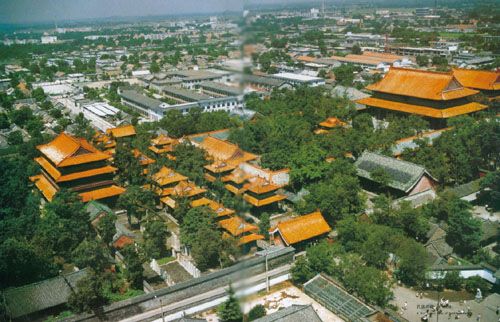|
||||||||||||||
|
||||||||||||||
Confucius TempleConfucius TempleThe temple started out as a simple memorial hall and mushroomed into a complex one-fifth the size of the Qufu town centre. Huge extensions during the Ming and Qing dynasties are mainly responsible for its present scale. The main entrance is in the south and leads through a series of portals emblazoned with calligraphy. The third entrance gateway, Arch of the Spirit of the Universe, has four bluish painted figures that refer to the doctrines of Confucius as heavenly bodies that move in circles without end. Magnificent gnarled, twisting pines occupy the courtyards in ConfuciusTemple along with over 1000 steles, with inscriptions dating from Han to Qing times-the largest bearing the tablets of praise are bixi (mythical tortoise-like animals), legendary for their strength. The tablets at Qufu are noted for their fine calligraphy; a rubbing once formed part of the dowry for a descendant of Confucius. In earlier dynasties, women were not allowed to set foot in the temple grounds; one tablet records the visit of Emperor Wuzong of the Yuan dynasty who brought his sister along C the first woman ever to enter Confucius Temple.
The core of the Confucian complex is Dacheng Hall, which, in its present form, dates from 1724; it towers 31m on a white marble terrace. The Kong family imported glazed yellow tiling for the halls in Confucius Temple,and special stones were brought in from Xishan. The craftspeople carved the dragon-coiled columns so expertly that they had to be covered with red silk when Emperor Qianlong came to Qufu lest he felt that the Forbidden City's Taihe Hall paled in comparison. The superb stone they are carved from is called 'fish roe stone'. The hall was used for unusual rites in honour of Confucius. At the beginning of the seasons and on the great sage's birthday, booming drums, bronze bells and musical stones sounded from the hall as dozens of officials in silk robes engaged in 'magnified dancing' and chanting by torchlight. The rare collection of musical instruments is displayed, but the massive stone statue of the bearded philosopher has disappeared- presumably another casualty of the Cultural Revolution. At the extreme northern end of Confucius Temple is Shengji Dian, a memorial hall containing a series of stones engraved with scenes from the life of Confucius and tales about him. They are copies of an older set that date back to 1592. In the eastern compound of Confucius Temple behind the Hall of Poetry &Rites, is Confucius' Well (a Song-Ming reconstruction) and the Lu Wall, where the ninth descendant of Confucius hid the sacred texts during the book burning campaign of Emperor Qin Shihuang. The books were discovered again during the Han dynasty (206BC-AD220) and led to a lengthy scholastic dispute between those who followed a reconstructed version of the last books and those who supported the teachings in the rediscovered ones.
|


